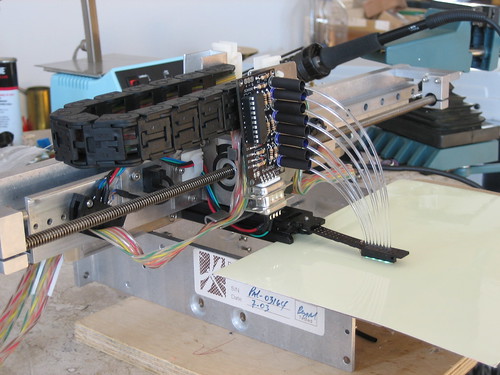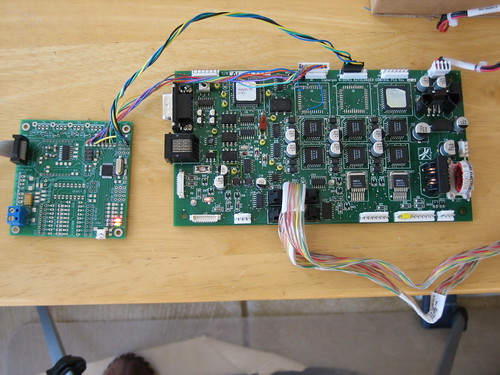May 20, 2009
Ghostmatrix
Well, this was supposed to be a weekend hack. Only it took a few months. In any case, it's kind of working now! What is it? It's a light printer that uses an array of UV LEDs mechanically scanned across phosphorescent paper, leaving a matrix of glowing dots that slowly fade. Hence "ghostmatrix." I scavenged the linear motor from SRL discard pile, and used an Adafruit Mini POV3 with custom software as the light engine. Here's a video of the beast in action:
Ultimately I want to hook this up so it will print tweets. Not there yet, but it will be @ghostmatrix on Twitter. Need to figure out how to get DMs or @replies into an RSS feed, or just buckle down and use the API.
Here's a closeup of the business end. Follow the link to see the labeled parts.

And for you geeks, here's the Frankensteined driver board. I thought it would be easier to reuse the existing board (only need access to 6 signals) but tracing wires on the autorouted multiple-layer board was the very definition of a PITA.

I should give credit where it's due; I used the "Atari-Small" 8x4 font from Tom's X11 Fonts and the spiffing Python bdflib font manipulation library.
UPDATE: some more information about parts and sources: the phosphorescent paper is
Grafix "Funky glow In the Dark" and a web search should get you the source. The lightpipes were (if I recall correctly) purchased from mouser.com. If they are still available I could not find a part number, but a similar (if shorter and more expensive) product is this: http://www.mouser.com/Search/Refine.aspx?Keyword=696-C011701S-150C
Ultimately I want to hook this up so it will print tweets. Not there yet, but it will be @ghostmatrix on Twitter. Need to figure out how to get DMs or @replies into an RSS feed, or just buckle down and use the API.
Here's a closeup of the business end. Follow the link to see the labeled parts.

And for you geeks, here's the Frankensteined driver board. I thought it would be easier to reuse the existing board (only need access to 6 signals) but tracing wires on the autorouted multiple-layer board was the very definition of a PITA.

I should give credit where it's due; I used the "Atari-Small" 8x4 font from Tom's X11 Fonts and the spiffing Python bdflib font manipulation library.
UPDATE: some more information about parts and sources: the phosphorescent paper is
Grafix "Funky glow In the Dark" and a web search should get you the source. The lightpipes were (if I recall correctly) purchased from mouser.com. If they are still available I could not find a part number, but a similar (if shorter and more expensive) product is this: http://www.mouser.com/Search/Refine.aspx?Keyword=696-C011701S-150C
Labels: projects
Comments:
<< Home
Good job! :)
Have you considered using a hard disk? i've glued some glow in the dark sheet harvested from a dead exit sign and it would also allow the use of cheap SMD UV LEDs and a PIC + ULN2003 to drive them and the existing hard disk motor..
-Andre
Have you considered using a hard disk? i've glued some glow in the dark sheet harvested from a dead exit sign and it would also allow the use of cheap SMD UV LEDs and a PIC + ULN2003 to drive them and the existing hard disk motor..
-Andre
I could see this being a useful way to communicate into a dark room... invert the light output and mount it in a wall.
@Conundrum: thanks for the suggestion. I've found hard disk drives a little challenging to drive as they are brushless 3-phase, so you need some kind of position or back-emf sensing to know when to drive the coils. Have you figured out a good way to do this?
@demi0urgous: if by "axis" you mean the linear drive, I scavenged it from a protein sequencer robot. You could probably use an old printer or scanner just as well.
Post a Comment
@demi0urgous: if by "axis" you mean the linear drive, I scavenged it from a protein sequencer robot. You could probably use an old printer or scanner just as well.
<< Home
Subscribe to Posts [Atom]

